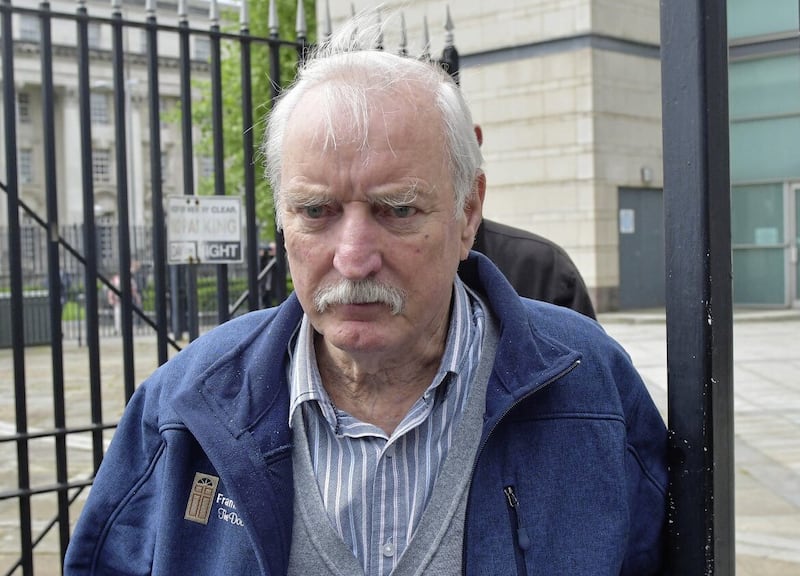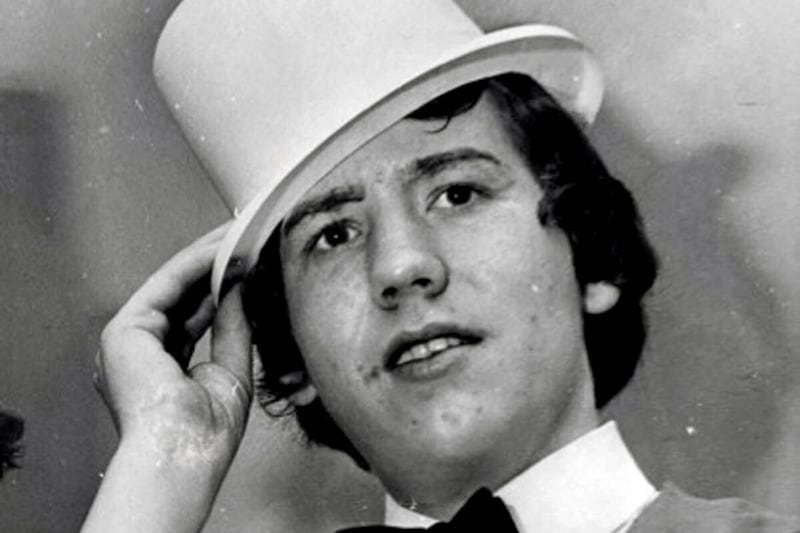At daily Mass in St Patrick’s Church in Crossmaglen, Kathleen Armstrong would often sit across the way from Mary Evans. They would nod to each other.
The two women, nursing the pain of missing sons, never talked to each other about their shared experience.
“The fear was on people,” says Anna McShane, Kathleen’s granddaughter and daughter of Charlie Armstrong, one of the disappeared. “They would sit across and acknowledge with a nod but that was it.”
It was not until 1994 a couple of women started to speak out, first Margaret McKinney, the mother of Brian, then Helen McKendry, the daughter of Jean McConville.

Then in 1995, at the Wave centre in Belfast, far away from south Armagh, Kathleen and Mary, mother of Gerry Evans, started to talk. And they could not stop, says Anna, who was also around the table.
These were among the moments that led to the Families of the Disappeared organising and four years later to the establishment of the Independent Commission for the Location of Victims’ Remains (ICVLR), which began work 25 years ago on Sunday.

Sandra Peake, the head of victims’ organisation Wave, says families suffered in silence, with many living “intimately” close to those who knew what happened.
“They were often led to believe they were still living. That was cruel, callous, brutal, unspeakable,” Ms Peake says.

Charlie Armstrong, a 57-year-old father-of-five, was due to pick up an elderly neighbour to bring her to Mass, then ferry his sister to the airport for a flight to England. He never turned up for either.
The family couldn’t ask the IRA but it was known the organisation would take cars, hold people for a couple of days, then release them. But Charlie’s car was found abandoned in Dundalk and he had disappeared.

Rumours circulated he was alive, that Charlie had joined a circus, was in another town with a couple of women or had otherwise run away. It was all nonsense, said Anna. She knew he had been murdered.

Depending on the area and circumstances, there were likely various reasons for the IRA – in the case of Seamus Ruddy, the INLA - to decide to secretly bury someone rather than simply murder them and let their families have a proper burial.
Former IRA member Ivor Bell, cleared of soliciting the murder of Jean McConville, was heard on the Boston Tapes describing a meeting during which he disagreed with secretly burying her.

Others had a different view, he said, arguing that because she had 10 children “they couldn’t take the heat from throwing her on the street.”
It was May 8, 1998, just weeks after the signing of the Good Friday Agreement. President Bill Clinton had met with the Families of the Disappeared, all of them women.
President Clinton told Prime Minister Tony Blair: “We’ve all taken our licks for Gerry (Adams)…..These women gave me an idea yesterday.”

Clinton added: “If you could work out the legalities so that people would not be prosecuted and the IRA could somehow direct people to the remains, so their families could give them a sanctified burial, that would have a huge psychological impact over there.”
Legislation in both jurisdictions followed and on May 26, 1999, the ICLVR began its work.
The IRA admitted it had murdered and buried nine, Seamus Wright, Kevin McKee, Jean McConville, Columba McVeigh, Brendan Megraw, John McClory, Brian McKinney, Eamon Molloy and Danny McElhone.
Charlie Armstrong and Mary Evan’s 24-year-old son Gerry, along with several others, were not among those the IRA acknowledged it had disappeared..
The body of Eamon Molloy was left in a coffin above ground in Faughart Cemetery near Dundalk days after the commission was established. Brian McKinney and John McClory were discovered in a bog in Co Monaghan in June.
Ms Peake remembers: “There was a clear assumption that the sites were correct, that it would be straightforward.”
People were getting ready for wakes, they were reluctant to leave their homes in case a call was missed, while others stood vigil at sites with the absolute belief bodies would be found, she adds.
But there were no more found until 2003 when the body of Jean McConville was discovered by chance at Shelling Beach on the Cooley Peninsula, some way from the site identified by the IRA.
On the back of an anonymous letter and map, searches were carried out by Charlie’s family in Co Monaghan but gardai were initially reluctant to become involved, says Anna. They were later persuaded to do so, but without success.
Deep frustration began to emerge among the families. Then Geoff Knupfer, a former Manchester police officer and academic with a keen interest in forensic science, came on the scene. He acknowledges having at the time a near complete lack of knowledge of the north.

He was asked to review the workings of the commission and deliver recommendations on how to improve its operations. It was a three month contract. He remained on the job for nearly 20 years.
“It came right out of the blue,” Mr Knupfer remembers. “I had no concept at all of the scale of it.”
There were major problems with the structure and workings of the commission, notes Jon Hill, who took over as head of the ICLVR last year but has been with the body since joining in 2006, also on an initial three-month contract.
“It was fragmented, with information provided by intermediaries, then on to the commission, then on to gardai,” says Mr Hill.
Among Mr Knupfer’s first tasks was to simply talk to the families, to the police on both sides of the border and the republican movement.
The latter was “clearly supportive, it was a big headache for them and they would have been just happy to see the back of it”.
Over the years, Mr Knupfer established connections with those directly involved in the secret burials. They expressed a range of attitudes and emotions,
There were those “who are absolutely desperate for it to be resolved, others did what the organisation told them to do”. Some were frightened their families or friends would find out what they had done.
Most of the bodies likely never would have been found without many republicans driving deep into their memories to help kick start the searches, both Mr Knupfer and Mr Hill acknowledge.
When able, investigators are keen to speak directly to those with information as part of the intelligence arm of the commission. They want to develop better access, ask better questions and build good will and rapport, including making sure no-one is ever arrested, says Mr Knupfer.
Investigators dive back with what sometimes feels like the same questions, sometimes over and over again, always trying to narrow an area down to arrive at a point where a ground search can start.
Other structural and personnel changes were put in place. The commission led with a cold case review process allied to a more forensic examination of areas once the intelligence is gathered. The commission gathered together a dedicated, though part-time, team of forensic archaeology and other experts.

Anna McShane, who spent years doing her own investigative digging, talking to people in the republican movement right up to Gerry Adams, lobbying politicians in Ireland and the US, also experienced a major difference with the arrival of Knupfer and then Hill.
“They talked to us direct and nothing got out that we were not told about beforehand,” explains Anna, also wanting to mention the actor Jimmy Nesbitt, a fierce supporter of the families over years.
Still, it was not until 2008 that another family was able to bury their loved one. Danny McIlhone’s remains were discovered in bogland near Blessington Lakes in Co Wicklow. Crucially, it followed two previous unsuccessful searches in 1999 and 2000.
Over the next years, the commission managed to help return seven more bodies to families.

By 2010, the Armstrong and Evans families were able to erect large posters in Crossmaglen appealing for information and including a confidential tip line, a loud and far cry away from the previous absolute silence.
Charlie’s remains were found in July 2010 in Monaghan, not far from the spot marked in that anonymous map and some 300 metres from where those of McClory and McKinney were discovered 11 years earlier. Gerry’s were found three months later in Co Louth.
Four bodies remain undiscovered, Columba McVeigh, Joe Lynskey, Robert Nairac and Seamus Maguire, a 26-year-old who vanished from his Lurgan home in the 1970s and was the last to be added to the list, in 2022.

Rosalie Flanagan, one of two commissioners along with former Irish Government senior civil servant Tim Dalton, said there is an entirely “humanitarian focus” and nothing political about the decades long work of this body.
Jon Hill admits the four cases still being investigated have leads that are less obvious, making the job more and more difficult
But he added: “Contacts with organisations continue, but to the point where there are no more leads, that might happen, but we are nowhere near that now.”
Ms Flanagan recently attended a cemetery Mass and was standing close to where the Lynskey family grave was situated. Joe’s name is etched in stone.
The family of Seamus Maguire, when told his name would be added to the list, said simply: “The family’s wish is that he is brought home and given a Christian burial.”
“Where would we be if the commission was not there,” says Dympna Kerr, the sister of Columba McVeigh.

Work is continuing to find the body of her brother, with investigators sure it is buried in the Bragan Bog in Monaghan, but the terrain is treacherously difficult to search.
Anna McShane is in touch with the family of Robert Nairac, the young British Army captain who disappeared in 1977 not far from her home in south Armagh. He will be found, it will happen, she says with determination.
Every year on Palm Sunday a service is held at St Patrick’s Cathedral in Armagh for the families of the disappeared. Those whose loved ones have been returned continue to attend - to support those still waiting.
“We are one big family now,” says Anna.
* Anyone with information on any of the missing can visit www.iclvr.ie for confidential contact details







